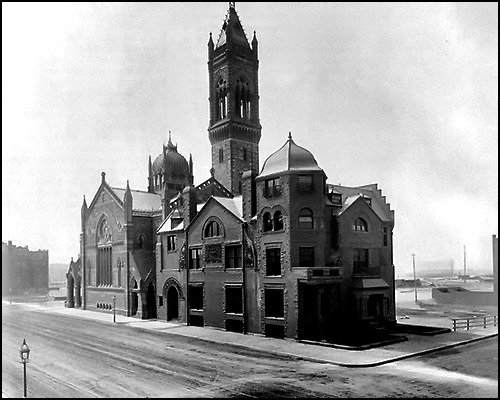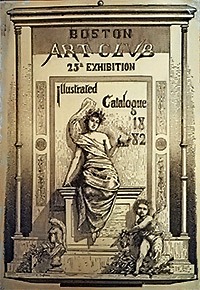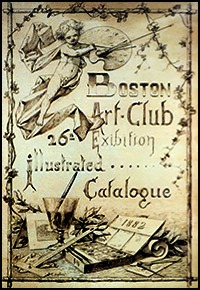

“The work done in Boston during the years 1882-5 by Tommaso Juglaris is certainly one of the finest and interesting displays of art work that has been seen in Boston…. It seems almost impossible that Mr. Juglaris could accomplish so much during the limited time mentioned.”—The Boston Art Club (Undated review, Juglaris Album).

With the profits in hand from stained glass commissions in Boston and elsewhere, Juglaris was at liberty to pursue other even more rewarding art endeavors. Beginning in 1881, he joined the Boston Art Club, one of the city’s important, newly-forming cultural institutions. He became an active member. The club became a gateway for Juglaris into Boston’s art milieu. Many Boston Art Club members spoke French; a few were even conversant in Italian, making it easier for Juglaris to communicate and feel at home.


At a Boston Art Club gathering Juglaris met American Art Review editor Sylvester Koehler. The respected and influential Koehler, who had previously experienced his own conflict with Prang, called upon Juglaris for numerous magazine illustrations. This added to Juglaris’s income, as well as recognition of his talents.
Following the showing of his two massive Paris Salon paintings, The Invasion and Paolo Veronese in Venice or Venetian Promenade, at the Boston Museum’s “Living American Artists” Exhibition in October 1880, Juglaris chose the nearby Boston Art Club as the venue for three further exhibitions of his work. The first was mounted in 1881 in tandem with paintings from the brush of his friend and fellow Thomas Couture disciple John Ward Dunsmore. The second in 1882, hosted in the gallery of the new Boston Art Club clubhouse on Newberry Street, featured samples of his decorative designs. As the Boston Evening Transcript was prompted to observe: “The decorations by Mr. Tommaso Juglaris now on exhibition at the Art Club are being greatly admired.” (“Art & Artists,” Boston Evening Transcript, July 12, 1882, 6) Further recognition arising from this second Boston Art Club exhibition came with the August 1882 issue of Folio. For its “monthly drawing” this self-declared “Journal of Music, Drama, and Literature” featured a measure of what Art Club patrons had already viewed for themselves—namely, “a section of frieze decoration by Tommaso Juglaris, containing seven figures of dancing children.” Enhancing Juglaris’s celebrity, Folio included a “brief biographical sketch.” (“Periodicals,” Boston Evening Transcript, July 25, 1882, 6) Finally, Juglaris’s third Boston Art Club exhibition in 1885 remained an entirely solo affair, highlighting drawings and paintings completed by the artist over the past three years. (“Juglaris Exhibition,” Boston Evening Transcript, March 26,1885, 6) Obviously grateful for the overall receptivity of Boston Art club members to his art, Juglaris made himself useful to his new colleagues by illustrating for their organization three successive exhibition catalogue covers, specifically for the years 1881, 1882, and 1884.
In 1882 Juglaris entered a competition for a teaching position at the Boston Art Club. In a bravura performance, Juglaris competitively outdrew seventeen other contestants, winning the job as teacher-in-residence for the elite club comprised of artists and wealthy art patrons. Thereafter, Juglaris taught figural drawing three full days each week, while also supervising two “assistant professors.” Suggesting an institutional equivalence to Italy’s great civic art academies, Juglaris chose in his personal memoirs to describe the Boston Art Club’s educational program as the “Boston Academy of Art.” He clearly relished the opportunity to instruct hundreds of fellow Boston artists eager to learn European painting techniques and traditions. Proud to find himself at the center of Boston’s art life, largely thanks to his teaching role at the Boston Art Club, he later recalled: “I had become the professor of all the painters in Boston. In addition to the good pay, it was a place of honor that raised me immensely in the public’s consideration.”
At the time of his selection by fellow artists to serve as the Boston Art Club’s teacher-in-residence, the organization was still settling into its new towered clubhouse at the corner of Newberry and Dartmouth Streets in the still somewhat undeveloped Back Bay, just a side street block from Copley Square where the Boston Museum of Fine Arts had opened its doors in 1876. Informed by his own educational experience at Turin’s Albertina Academy where studies from the nude were considered de rigueur for artistic training, Juglaris was instrumental in the design of the clubhouse’s own amphitheater or “theater of the nude” for artists wishing to sketch and draw from live models with their naked form exposed. During Juglaris’s tenure as a highly experienced, capable and cosmopolitan teacher, the Boston Art Club remained for the city’s artist community one of the foremost locations for professional education, exhibition, and invaluable socialization.